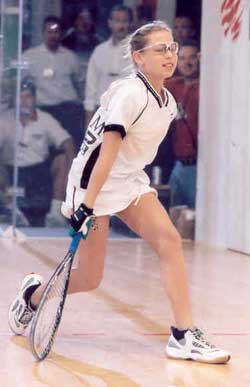
March - April 2003
Vol. 14, No. 2 | Contents
Juniors 1,2,3
This information appears, in poster form, as a pull-out in the center of the current print edition.
 |
Following
are a series of outlines that can be used by any teacher, parent or
certified instructor interested in promoting junior racquetball in their
area, using a gradual progression from one-wall (gymnasium or outdoor)
racquetball to a more advanced junior league program. Developed for
players from age 6 through 18, these levels may be applied and used in any
participating club or school. Cincinnati "Big Hitter" Andy McGuffy (left) and Paige Hunter of Naples, Florida (above), showed their stuff on the glass court at the U.S. OPEN last fall. Photos: Vicki Hughes. |
| Recreational In-School Program (1 wall) | |
| Skill Level | None, to moderate, racquet skills |
| Facilities | One
Wall, 20' x 40' Floor space 20' x (Gymnasium is excellent) |
| Equipment | Racquet, ball, eyeguards, gym shoes |
| Lesson Plan | |
| Week 1: | Explain equipment, safety, basic rules, show basic grip, allow children to ”just play” (45 minutes). |
| Week 2: | Show basic forehand stroke; show basic serve (go over service line) to right side of court; show basic return to front wall; Allow students to ”play.” |
| Week 3: | Show basic serve to left side of court; Lob serve which hits high on front wall and is hit just hard enough to go over service line; show basic return strategy and moving to center of court; Allow students to ”play”. |
| Week 4: | Inform students of 4-wall racquetball; Explain there are games with three and four persons; Allow student to play 7-point games utilizing basic rules of racquetball; Give students information about clubs; professional side of sport; USRA. |
| Instructor Guidelines • Cover the basic rules of one-wall racquetball, basic safety and court etiquette, basics of grip and stroke. | |
| Recreational Club Program (2, or 4 wall) | |
| Skill Level | None, to moderate/advanced racquet skills |
| Facilities | Outdoor (2 wall), or indoor (4 wall) courts |
| Equipment | Racquet, ball, eyeguards, gym shoes |
| Lesson Plan | |
| Week 1: | Basics of equipment, safety, (45 minutes); Basic grip and forehand stroke; Rules (one bounce for 10 and over, two bounce for 8 and under); Don't worry about floor lines; Let kids”play,”and run around the court. |
| Week 2: | Instructor sets up the ball for student to hit after first bounce; Instructor ”rallies” with student (either one or two bounce); Teach basics of forehand; Let students just ”play” and run around the court. |
| Week 3: | Teach basic rules of service; Show forehand ”Drive” serve (any serve that goes over line to right side); Show basics of return; Let students ”rally” serve and return. |
| Week 4: | Show basics of backhand; Instructor sets up ball for students to hit after one bounce; Show return or serve on backhand side; Allow students to rally. |
| Instructor Guidelines • Provide information on more advanced lessons and interscholastic racquetball. For development of lesson plans beyond Week Four contact your local AmPRO Instructor. | |
| Inter-school/club, PE Class Option | |
| Skill Level | None, to moderate, racquet skills |
| Facilities | Court or Club near the school |
| Equipment | Racquet, balls, eyeguards (required) |
| Developmental Plan | |
| A. | Contact
club regarding non-prime time use of courts |
| B. | Contact
school (Athletic Dept/Administration) to arrange off-campus Phys Ed
racquetball class. |
| C. | Development
of an educational (teaching) plan with qualified instructors. |
| D. | If
the Physical Education teacher is qualified, develop a plan with them. If
there is no qualified club or PE teacher, find a certified instructor to
teach classes. |
| E. | Develop
curriculum by consulting with an AmPRO certified instructor [usampro.org] |
| F. | Verify transportation requirements to the club with all parties (school-club-instructors). |
| Inter-school/club, Competitive Leagues | |
| Skill Level | Moderate
to Advanced racquet skills Primary or Secondary School |
| Facilities | Club,
donating ”non-prime time” hours |
| Equipment | Each
student should have their own equipment (racquet, glove, eyeguards, shoes,
workout wear). |
| Assumption | Students have established skill level/knowledge, which allows them to participate in a competitive setting. |
| Developmental Plan | |
| A. | Contact
clubs to verify usage |
| B. | Contact
schools to obtain administrative approval |
| C. | Organize
volunteer group to assist with organization/events |
| D. | Recruit”Key”
individuals in each school as liaisons |
| E. | Distribute
information |
| F. | Recruit students |
| Recommended
References [at www.usrastore.com] • Programming for Racquetball • Coaching Racquetball Level One • Winning Edge Series - Racquetball |
|
John Ferguson [USRA Junior Council Chairman]
4250 SW Council Crest, Portland OR 97201
503/223-4087 (h) — ferguson85@attbi.com
[Request “Oregon Junior Racquetball Organizational Handbook”]
Top | RacquetballMagazine.com | USRA.org
© United States Racquetball Association -- All Rights Reserved